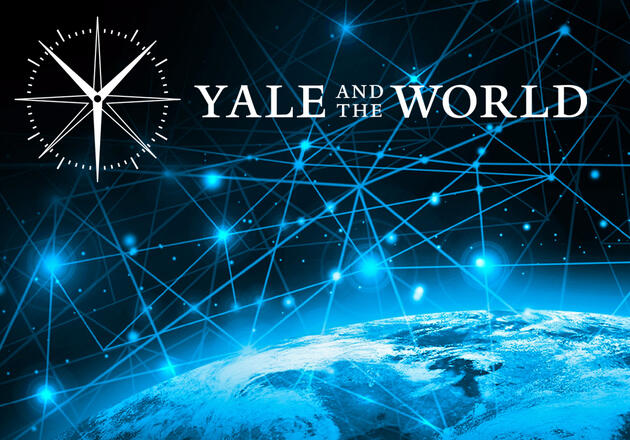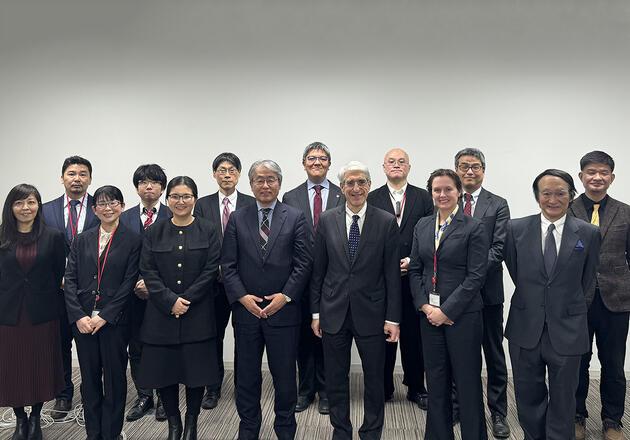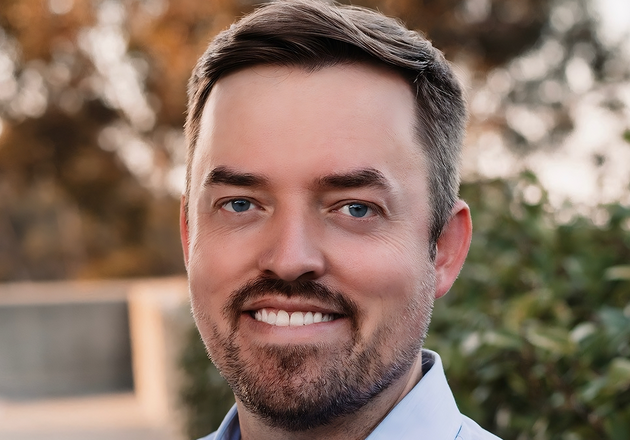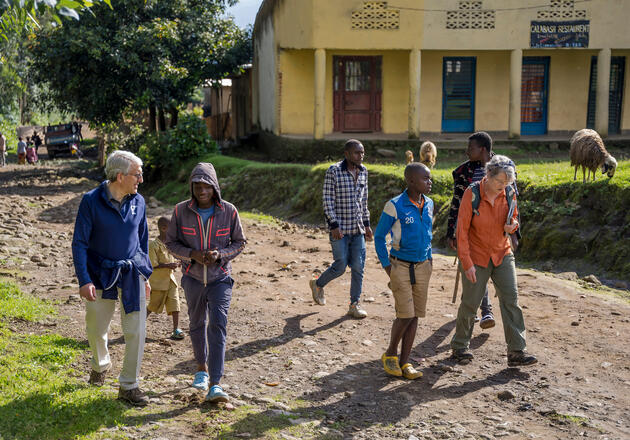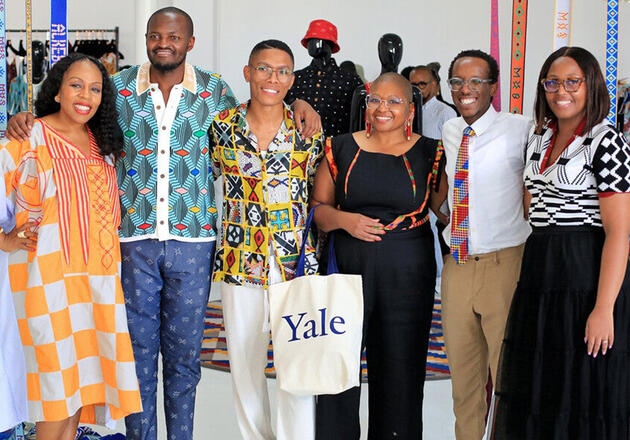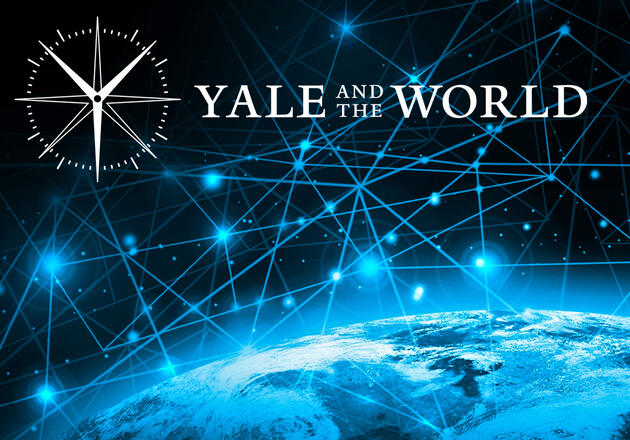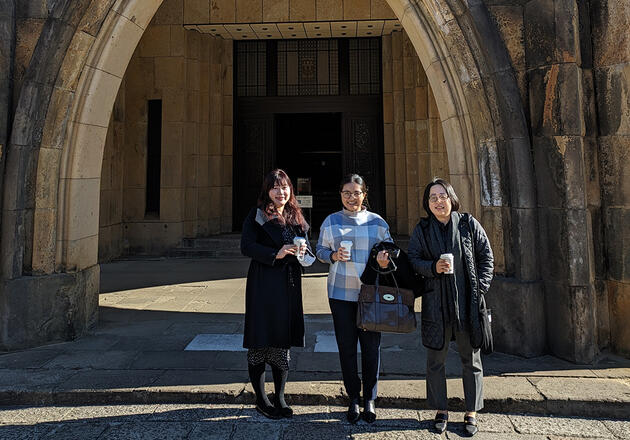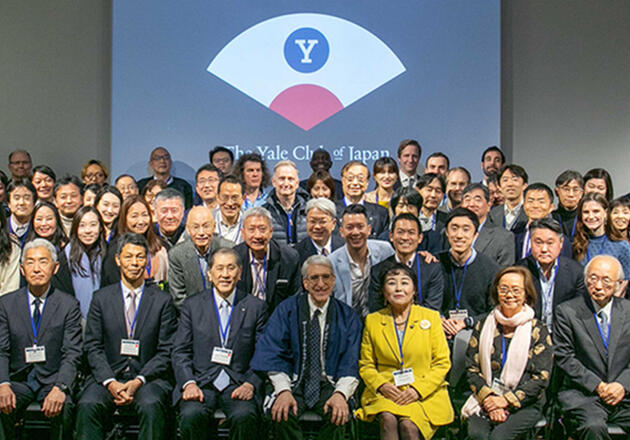Yale Himalaya Initiative
Art historian studies the makers of medieval India
Subhashini Kaligotla, assistant professor of art history, points to a photograph on her computer screen of elaborate sandstone towers at Pattadakal, a medieval temple complex in northern Karnataka, India.
“I always ask my students if they see different architectural styles,” she said, seated in her office at the Loria Center.
She points out two distinct types of tower: One is curvilinear and rises vertically while the other is pyramidal and tiered. The first style is associated with the architecture of North India, the other with South India.
About the size of a New York City block, Pattadakal features nine Hindu temples and a sanctuary dedicated to Jainism — a religious tradition that advocates nonviolence as a pathway to spiritual enlightenment — as well as numerous smaller shrines. The complex, which was built in the 7th and 8th centuries C.E, is located on the Malaprabha River in the Deccan — a vast plateau that stretches over the center of peninsular India. The region is widely considered a crossroads where art makers incorporated architectural styles and artistic ideas from various parts of the Indian subcontinent.
Kaligotla’s research critically examines the premise that makers in medieval Deccan — architects, artists, poets, and patrons — unconsciously borrowed from their counterparts in neighboring regions.
“I’m looking more carefully at the choices the makers in the Deccan made — not just that they knew about these styles and ideas from other regions, but how they adapted them for their Deccan milieu, and how they gave new meanings to these forms that they may have known from other contexts,” said Kaligotla, who joined the Yale faculty late last summer.
Pattadakal, a UNESCO World Heritage Site, is the pivot for a book Kaligotla is writing on the agency of the makers who designed and built sacred sites in the Deccan during the medieval period.
The sites present intricate hybrids of architectural styles, languages, scripts, and religious traditions. Hinduism, Buddhism, and Jainism are represented at places Kaligotla studies. Temples and monuments are inscribed in Sanskrit as well as local languages.
“I’m trying to give context to the makers’ choices in the architectural realm and situate them vis-a-vis other kinds of choices that were made, whether in the realm of religion, or politics, or language,” she said.
Kaligotla is not only interested in studying the individual buildings at Pattadakal and other Deccan sites, but also the structures’ relationship to one another and to the landscape. She notes that many of the sites, especially sacred sites like Pattadakal, are located near water. While noting that water has a ritual importance, Kaligotla asserts that other reasons must have driven medieval makers to build close to rivers, such as agricultural and economic considerations, or for pleasure and scenic beauty.
“These sites were the locus of a great amount of social activity,” she said. “People visited these places because they were beautiful and they were the site of festivals and other social occasions. The presence of water was significant to that experience.”
The blending of northern and southern styles occurred not just between structures in a complex, but also among the elements of a single building, Kaligotla said.
“You see so much hybridity and mixing in the microarchitecture of individual buildings,” she said. “A temple’s tower may be curvilinear, which is the northern style, but a cornice, door lintel, or exterior wall may feature southern forms. The makers were playing with many different forms.”
The makers covered the temples in elaborate ornamental details.
“The entire surfaces of these temples — exterior and interior — are heavily sculpted and deeply faceted,” she said. “It’s figural imagery, floral imagery, geometric, and abstract imagery. You have to imagine that you are surrounded by ornament: the walls, ceiling, and pillars. You are enveloped in sculpted surfaces replete with imagery.”
Kaligotla is exploring how ideas about ornament can be used to understand the medieval temples and the people who made them.
The ornamentation was essential to each building’s form and function, drawing a contrast from the modern day, in which ornament is considered decorative but inessential to a structure’s purpose, she explained.
“That was not the medieval or ancient Indian understanding of ornament,” she said. “They thought of it as necessary for a building’s completion. Without ornamentation, these buildings couldn’t function. They wouldn’t be protected from malevolent forces. Ornament in the medieval Deccan has many functions: It augments, magnifies, and strengthens.”
The temples at Pattadakal and other sites Kaligotla studies bear inscriptions about their makers, providing important textual evidence, including the names of architects and sculptors. An inscription on a temple at Pattadakal explains that the building’s architect fashioned cities, temples, and palaces, while also designing furniture, such as seats and couches, Kaligotla said.
Whether an inscription is in Sanskrit or a local language offers clues as to a maker’s status as the former was considered more prestigious and cosmopolitan and likely would have been used to describe an important architect or patron, Kaligotla explained.
“At least some of these makers seemed to have had a high status,” she said. “It’s not copious amounts of evidence but it is enough to suggest that there were categories of makers using different languages to represent themselves. There seems to have been differences in the way these makers were perceived.”
Kaligotla is a maker in her own right. She is a practicing poet whose debut poetry collection, “Bird of the Indian Subcontinent,” was published in January. Her research, including her reading and fieldwork in India, inspired many of her poems, she said.
“Certainly my scholarship has fed my poetry,” she said. “I also think writing poetry and inhabiting that sort of consciousness has helped me as a scholar. I’m grateful that whether I’m working as a poet or an art historian, I am shaping language. I appreciate that and hope that I bring the crafting of language from poetry to art history and also vice versa.”
Kaligotla was born in coastal Andhra in southeast India. She moved with her family to the Middle East when she was nine years old. She came to the United States to attend Rutgers University, where she got a bachelor’s degree in electrical engineering and worked in the telecommunications field for many years before changing course and earning an M.F.A. in creative writing and later a Ph.D. in art history and archaeology from Columbia University.
“I have a hybrid background,” she said.
Before coming to Yale, she was a postdoctoral research fellow of the Kunsthistorisches Institut in Florenz and based in the Museum für Asiatische Kunst in Berlin.
Kaligotla says she appreciates Yale’s invigorating scholarly environment.
“I just knew that my colleagues would be doing excellent work, and it would be a vibrant and stimulating intellectual community, which is necessary to one’s work,” she said.
She taught two undergraduate courses in the fall and appreciates the ability to teach from Yale’s collections.
“It’s been exciting to think of the Yale University Art Gallery and the Yale Center for British Art as extensions of the classroom,” she said. “To transition from images in textbooks to actually being with the objects is a great experience for students and teachers.”
Institute of Sacred Music Presents Aastha Goswami
Yale’s Institute of Sacred Music, in collaboration with the South Asian Studies Council at Yale, presents a free lecture demonstration of North Indian vocal music by Aastha Goswami on Friday, September 28 from 12 to 1 p.m. at Miller Hall at 406 Prospect Street. The lecture is free and open to the Yale community only, and light refreshments will be served.
Aastha Goswami received her music training from the prestigious ITC SangeetResearch Academy in Kolkata where she trained under the tutelage of Pt. Arun Bhaduri and the legendary Padma Vibhushan Smt. Girija Devi Ji. Performing for more than 20 years all over India, with numerous awards and honors to her credit, Aastha is based in Vrindavan, the cultural-spiritual center of Vaishnavism/Krishna worship.
Deeply entrenched in the famous Kirana (Gharana) classical musical tradition of Hindustani music, she has also immersed herself in the stream of Devotional music. Aastha has evolved her unique style of Padavali Gaayan, which imbibes the intricacies of Khayal Gayaki suffused with deep emotions. While her repertoire showcases traditional classical compositions and Thumris, she also enriches her performances with her rare collection of compositions of the Braj region like Krishna-Radha Janamotsava Badhai Gaan, Jhoola, Ashtyaam Raag Seva, and songs about different seasons and festivals like Hori, Basant, and Saavan.
As the renowned classical dancer Padmashri Geeta Chandran says: “Aastha Goswami’s voice is like honey flavored by the rarest saffron of selfless sadhana and when this dedicated riyaaz is perfected at the feet of Radharamanji in Vrindavan, it transcends time and space to pierce infinity! She is on a different internal journey; reaching Ishwara through Swara!”
This event precedes a full concert on Saturday, September 29. See Autumn Moon: The Music of Divine Dance, An Evening of Hindustani Music with Aastha Goswami for more details. Those outside the Yale community that are interested in attending can email ismevents@yale.edu for more information.
Y-RISE initiative enlists faculty expertise in fight against poverty
A new Yale-based research initiative is developing the science needed to scale-up promising anti-poverty programs so that they can benefit the greatest number of people.
The Yale Research Initiative on Innovation and Scale, or Y-RISE, brings together leading researchers in economics and political science from Yale and institutions around the globe to tackle questions related to expanding programs that have proven effective in small-scale randomized-controlled trials.
Mushfiq Mobarak, professor of economics at Yale and Y-RISE’s faculty director, explained that the program evaluations that social scientists conduct can demonstrate an intervention’s potential, but they are typically not designed to predict what will happen when an initiative becomes policy and is delivered to hundreds of thousands of people.
“The world becomes vastly more complicated when a program is scaled up,” said Mobarak, who has a joint appointment in the Department of Economics and the Yale School of Management (SOM). “We aim to answer questions about what will happen when a program that succeeded in a handful of villages is expanded to assist hundreds of thousands of people.”
Y-RISE is supported by an anonymous donor and The Whitney and Betty MacMillan Center for International and Area Studies at Yale.
“We are excited to have Y-RISE at the MacMillan Center,” said Ian Shapiro, the Henry R. Luce Director of the MacMillan Center and Sterling Professor of Political Science. “The groundbreaking work Professor Mobarak is spearheading at Y-RISE has the potential to have a tremendous impact on poverty. We look forward to learning more about the initiative’s research over time and how it will help to alleviate one of the world’s most intractable problems.”
Building research networks
The initiative features five research networks, each of which was assembled to address a specific set of challenges and implications in bringing anti-poverty programs to scale. Each network is led by two conveners and has a roster of contributing researchers, including more than a dozen Yale faculty members all told. The contributors represent a variety of fields, including development economics, macroeconomics, operations research, and management, econometrics — the use of statistical methods in the study of economic data and questions — as well as political science.
One of the networks examines how a large-scale intervention will change the behavior of the government, political leaders, and their constituents.
“Scaling up a program often requires us to overcome the resistance of stake-holders who are reaping the rents of the status quo,” said Gerard Padró i Miquel, professor of political science and economics at Yale, who will convene the Y-RISE network on the Political Economy Effects of Policy Interventions. “Those actors may also try to shape implementation with an eye to protecting political and economic rents. It is important to understand what this means for program effectiveness, as these efforts, which only kick in at scale, can lead to substantial subversion of the goals of the policy.”
The effects of policy interventions on electoral outcomes and the incentives of politicians and voters is being studied by other Y-RISE-affiliated faculty, including Yale political scientist Ana De La O Torres and University of California-Berkeley economist Frederico Finan, a co-convener of the political economy network.
Another research network investigates how an intervention could affect people who do not directly receive its benefits. These “spillover” effects can undermine or enhance a program’s value, Mobarak said.
A third will examine a policy intervention’s effects on the overall economy, taking advantage of Yale’s expertise in macroeconomic analysis of growth and development through the participation of Fabrizio Zilibotti, the Tuntex Professor of International and Development Economics; Michael Peters, assistant professor of economics; and Kevin Donovan, assistant professor of economics at the Yale School of Management.
“Just because a program works in Northern Bangladesh doesn’t necessarily mean that it will work in other parts of Bangladesh or India or Peru,” said Ed Vytlacil, a Yale professor who specializes in econometrics and will convene the Y-RISE network on Evidence Aggregation and External Validity. “We need to develop new methodological techniques to aggregate evidence from different places to predict how a program would change if you were to change its underlying conditions.”
In addition to the geographic dimension, time is an important consideration in bringing a program to scale, according to research by Mark Rosenzweig, the Frank Altschul Professor of International Economics and a convener of the network on spillover effects of policy interventions. His paper with Christopher Udry, a former Yale economist now at Northwestern University, showed that results from a program evaluation conducted in any given year will be sensitive to aggregate shocks, such as weather conditions prevalent in that year. Predicting the effects of that program at scale may require conducting studies over time, or combining the program evaluation data with longitudinal data on aggregate conditions, according to Rosenzweig’s research.
A fifth network, being developed in partnership with Yale SOM’s Program on Social Enterprise (PSE) led by Professor Rob Jensen, will answer questions concerning the practical and operational challenges of implementing policy interventions at scale.
“Giving insight into how to effectively deliver products and services, and how to design organizations to accomplish those goals, is a fundamental objective of management research,” said Edieal Pinker, deputy dean and the BearingPoint Professor of Operations Research at SOM. “The mission of Y-RISE is perfectly aligned with the framework for SOM’s PSE, which seeks to marshal faculty expertise and student engagement toward having an impact on important societal challenges globally.”
Yale’s strength in all the related fields makes it an ideal place for this research initiative, said Alan Gerber, dean of the Social Science Division of the Faculty of Arts and Science at Yale. “We have the range of expertise needed to bring together the methodologies and techniques from multiple fields.”
Mobarak adds, “It’s also important to recognize that there are really smart people at research universities around the world who can contribute to the development of this new science, who we need to bring into the fold.” The initiative is therefore Yale-centered, but outward facing, he notes.
Setting an agenda, forging partnerships
Y-RISE researchers have embarked on two interrelated streams of activity. First, they are developing a research agenda around scaling up policy interventions, identifying gaps in the existing research, and developing the methods needed to answer relevant questions.
The second stream involves setting up partnerships with implementing organizations, such as government institutions or non-governmental organizations, that have the capacity to implement anti-poverty programs and start delivering them at scale.
Evidence Action, an organization that scales up evidence-based anti-poverty interventions, is one such partner. They have started a new collaboration with Y-RISE affiliate and Yale economics professor Costas Meghir to scale up his research agenda on Early Childhood Development. The goal of the research is to understand the benefits of intervening in the education of children early on in their lives as a way to increase their human capital and help them escape poverty, as well as figure out the most cost-effective ways to provide these interventions. The collaboration with Evidence Action will expand the reach of the research project — thus far focused on Colombia and India — by designing and testing scalable early childhood interventions in Africa.
Mobarak, who is from Bangladesh, knows firsthand the difficulty of bringing an anti-poverty measure to scale.
He and Evidence Action collaborated to test and develop No Lean Season, a seasonal migration program that provides $20 subsidies to poor, rural families in northern Bangladesh to promote seasonal migration. Individuals use the money to travel cities for temporary work during the lean season — the period between the planting of rice crops in August and the January harvest — when jobs are scarce in the countryside and food insecurity is widespread.
The program has been scaled to reach 1.4 million people in Bangladesh and is being tested in other countries. Households involved in the program consume an average of 550-700 additional calories per person per day.
“I know from experience the challenges of developing and testing a program and taking it to scale,” he said. “I’m confident that Y-RISE and its partners can develop techniques and scholarship to guide policymakers and facilitate large-scale implementation of programs that improve the lives of people throughout the globe.”
Students Explore Languages with National University of Singapore’s Centre for Language Studies
This is an external news story
Click here to read it: https://www.yale-nus.edu.sg/newsroom/29-august-2017-yale-nus-students-learn-diverse-languages-through-teleconference/

